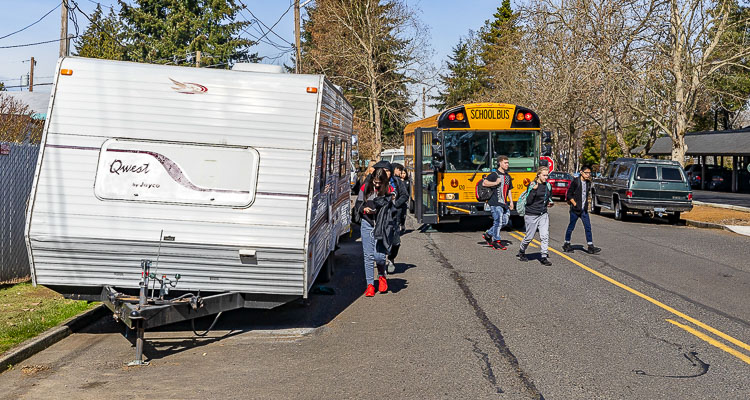The local focus will be identifying and supporting youth ages 12-24 who are experiencing homelessness in Clark County
Clark County is one of five new “Anchor Communities” announced today (Feb. 3) by A Way Home Washington (AWHWA). This more than doubles the number of communities working intensively to prevent and end youth and young adult homelessness in Washington, which is estimated to be 13,000 to 15,000 young people statewide.
The Anchor Community Initiative is the flagship program of AWHWA, a statewide movement to prevent and end homelessness for unaccompanied youth and young adults. The program is undertaken in partnership with the Office of Homeless Youth.

The local focus will be identifying and supporting youth ages 12-24 who are experiencing homelessness in Clark County. This includes youth who are unaccompanied by a parent or guardian, living in places not meant for human habitation, residing in a shelter, couch surfing, doubled up, and/or fleeing domestic violence or human trafficking.
“We know homelessness itself is a form of trauma,” shares Sunny Wonder, director of diversion at Council for the Homeless and local Anchor Community Initiative lead. “Youth struggle with physical and mental health challenges and with their education. Council for the Homeless and Janus Youth Programs have a long history of successful local collaboration and are committed to bringing partners to the table and involving youth with lived experience in implementing solutions to the unique needs of this age group. Being a part of the Anchor Community Initiative will support our community’s vision of ensuring all young people have a safe, stable place to call home.”
During the 2021 legislative session, additional resources were directed to make expansion of the Anchor Community Initiative. Expansion of this national model builds on recent milestones achieved by Anchor Communities, including Spokane, which has become the largest community in the United States to achieve a sustained, measurable reduction in youth and young adult homelessness; and Walla Walla, which reduced homelessness for young people by 20 percent over a six-month period.
Clark County together with Skagit County, Whatcom County, Thurston County, and Jefferson and Clallam Counties applied and were selected to become Anchor Communities. These communities join the initial and continuing Anchor Communities of Pierce, Spokane, Walla Walla and Yakima counties in bringing together diverse coalitions to work across systems and silos, sticking with their collective approach until they have functionally ended youth and young adult homelessness. “Functional zero” means a community has the ability to prevent most homelessness, quickly identify all of the unaccompanied young people who are experiencing homelessness or housing instability at any given time, and quickly resolve homelessness with connections to safe and stable housing.
“The circumstances that lead to the experience of homelessness can vary greatly, so solutions also need to be varied. Tailoring approaches to prevent and end homelessness that take into account the circumstances of young people and the communities they live in is the focus of the Anchor Community Initiative,” said Julie Patiño, executive director for A Way Home Washington. “These intensive whole-community-driven, data- and solution-focused efforts are increasing our understanding of what works in preventing and ending homelessness for young people. It also powers our ability to proactively share learnings, and provide training and assistance to all interested communities across Washington state.”
Anchor Communities receive a wide array of supports, including strategic coaching, guidance on collecting and utilizing quality data, subject matter expertise, tools to uncover inequities and make progress toward key milestones, connections to and learning with other Anchor Communities, and access to state-level funding and policy advocacy based on local needs.
Promising approaches to effectively prevent and end homelessness for young people have been identified and are actively being used in Anchor Communities, including:
• Personalized, real-time data. Communities that create a comprehensive, real-time “By-Name List” of every unaccompanied young person in a community experiencing homelessness or housing instability can better pinpoint the specific services and system improvements needed to quickly house each individual.
• Collaboration across systems. Community coalitions, representing diverse systems, meet regularly (“case conferencing”) to review their community’s By-Name List and collectively identify unique approaches to help house each and every individual identified.
• Prevention resources. Communities are connecting schools, juvenile justice, behavioral health and other systems that can more easily identify the young people they serve who have housing instability to a dedicated service that is equipped to quickly connect them to needed resources and support.
• Quick access to flexible funds. Service providers receive training to quickly access flexible funds for expenses such as rental assistance, security deposit and application fees to prevent a young person from falling into homelessness or to quickly divert them out of homelessness.
• Insights from youth with experience. Communities that actively engage a Youth Advisory Board learn from young people with experience of homelessness who are uniquely qualified to identify cracks in systems and pinpoint specific areas to change.
For more information on A Way Home Washington and the Anchor Community Initiative, visit https://awayhomewa.org.
Information provided by the Council for the Homeless.




